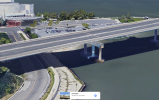The great members who do the crash assistance on Mavic Pilots, stated the IMU error was from after the crash. If you view the log, everything that is in the log after the last stick input (13 min 14.1 s) is not in any way indicative of what the aircraft did. It never moved forward or in the erratic path. It only flew straight back into the column, then fell and tumbled.
The aircraft went into salt water where it sat for 45 minutes until waders were brought on scene to recover the aircraft. We will never trust this aircraft for public safety missions again. We did replace it with an aircraft with a much better payload in the Autel Evo 2 Dual. But I do miss the Mavic 2 Enterprise Dual, it was rock solid until it wasn't.
Meta4's expert opinion:
How close to the bridge column do you think the drone was immediately before this happened?
Also could the Right Front Motor high RPM and no current be from the crash?
It will be as a result of propeller damage from the collision.
I am currently trying to write up an after action report with all findings about contributing factors to the accident and crash. I have already documented bad pilot decisions on going under the bridge, not aborting when satellites dropped in number
You had 5 seconds of flight (13:09.3 - 13:14.4) where the bridge blocked enough of the skyview to affect satellite reception significantly.
The flight controller was not confident in the location data for that period and the drone would have effectively been in atti mode for that period.
That is not necessarily a problem and just requires additional caution if flying close to obstacles.
The drone was safe and stable during that 5 seconds of the flight.
But after satellite numbers returned the data shows a discrepancy between indicated speed and GPS speed.
It's a bit hard to explain but it looks like the drone may have "jumped" to catch up with where it thought it was, which would account for the sudden unexpected movement.
The drone collided with something at 13:17.1.
Any error or warnings after that are a result of the collision, not indicating a cause.
In 0.3 seconds the pitch angle went from +65° to -77° while the drone rolled over 169°.
that was the cause of the IMU warning.
Link to full thread, and again I say, thank you to those great members who put in their time to help me come to a conclusion that went into an official Accident report as well as an After Action report.
Hello, I never wanted to have to post to this section of the forum, but my turn has finally come. I was flying for my job today in Public Safety and our Mavic 2 ED flashed an IMU Attitude error before immediately flying backwards into a concrete bridge support, falling onto its base and then...

mavicpilots.com
Read through the whole thread, it is very interesting to watch these guys pick apart the flight log and come to a conclusion.
I take responsibility for the decision to go under the bridge, but I needed to be under it to capture the underside directly under the bridge lanes as well as where the drone was pointing pre-crash as that was the temporary stairs to reach the temporary walkways under the bridge. I log training hours flying in Attitude mode and am pretty decent in being able to recognize when entering into the mode, fly in this mode or hold a somewhat steady position.
No one at first believed me when I stated that I had zero stick input and the aircraft just jumped. People assumed that I must of been playing around or of been BVLOS. I am in an associates degree program for sUAS Field Technician and by far have the most flight hours of anyone in our program and due to that I have seen and been part of multiple accidents and crashes. Others seem to think that sUAS aircraft are perfect and can never have an incident unless it was from pilot error. I unfortunately have seen 5 different manufacturer's sUAS do all kinds of crazy things and am no longer surprised when something happens.




